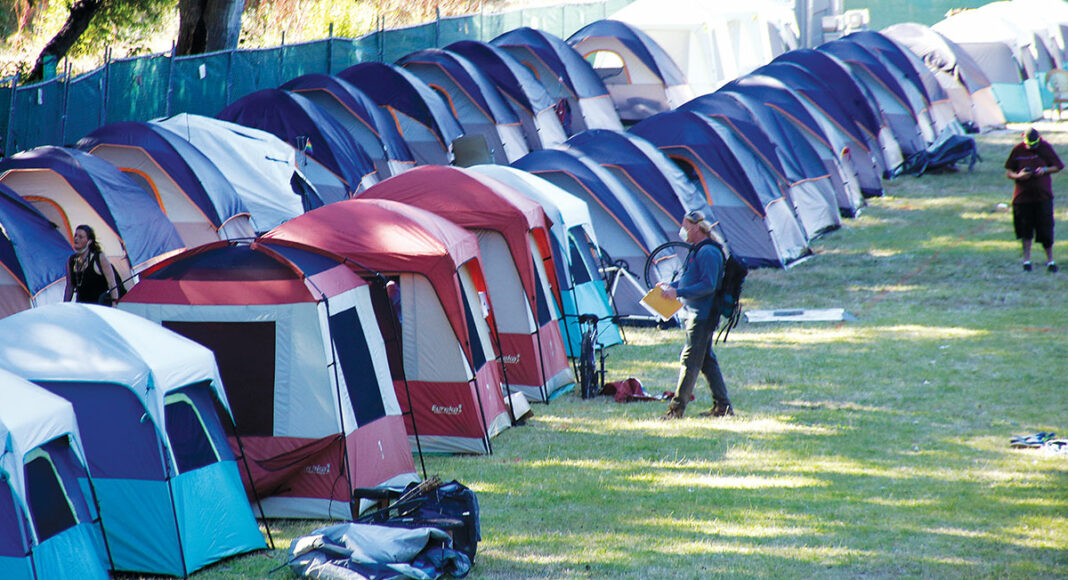This past March, in the early days of the Covid-19 pandemic, Santa Cruz County started hiring dozens of temporary disaster service workers to ease the burden of a health crisis unprecedented in the modern era.
These workers filled important roles, like staffing local shelters. They cared for the immunocompromised, the homeless, and the mentally ill.
Ten months later, many of these workers are still working for the county, but some are getting laid off for procedural reasons. The disaster workers themselves, people like R.C. Padilla, worry that the changes could be hard on the county’s most vulnerable residents.
“I know it’s hard for them, because they get adapted to you and you get adapted to them,” says Padilla, who’s worked as a temporary disaster worker since August.
When the county hired emergency workers like Padilla, no one had any idea how long the pandemic would last. But under California law, these workers aren’t allowed to work more than 999 hours in total in one fiscal year, which runs from July through June.
Padilla says she’ll likely reach her 999-hour limit in March, meaning that she expects to get a termination notice by then. The county has already started handing out termination notices to many of her coworkers.
These emergency workers, some of whom bring years of experience, have spent months getting to know their systems and the clients they serve. Without their expertise on the front lines, some aspects of county programs could be starting over from scratch.
Padilla, who has a background in mental health care and criminal justice, says she and her coworkers know how to de-escalate potentially violent situations and build a rapport with those they help.
“They trust us,” she says.
Helen, a client of the county’s emergency programs, has been living at a quarantine motel for the medically vulnerable for five months. She’s elderly and in a wheelchair. Helen, who asked to have her last name withheld, says it is frustrating to get paired up with a new employee after developing a relationship with someone.
“They don’t have the experience of dealing with elderly, mentally ill people. It doesn’t make sense,” she explains. “As long as these shelters are open they should have the same staff. I’ve got to feel safe.”
There have been some shifts in which workers the county is able to hire. In March 2020, Gov. Gavin Newsom signed an executive order that would allow counties to bring back retired employees.
Then, the Santa Cruz County Board of Supervisors sent Newsom a letter on May 29, asking him to take action and allow the county to do the same thing for temporary workers, but to no avail. Newsom’s office did not respond to emails from GT seeking comment.
County Supervisor Ryan Coonerty says the board has made a “bunch of attempts” to create more flexibility. “What we’ve heard back from the administration is that they are not changing the policy,” he says.
So instead, the county has opted to pursue another route.
Coonerty explains that the county has tried to keep as many existing positions in place as possible. In a Dec. 8 board meeting, the supervisors approved an item creating 45 new temporary full-time positions. The intention is to officially hire the county’s temporary employees.
Local emergency workers say it’s better than nothing, but the number is still shy of the 100-plus emergency workers currently working for the county.
Coonerty says he respects how much the emergency workers have stepped up in this time of need.
“It’s an incredibly important job these folks are doing in a pandemic,” he says. “We will continue trying to find every possible way to keep people working.”
At the same time, Santa Cruz County spokesperson Jason Hoppin says local funds are already stretched thin, with county employees on furlough. Even Health Officer Dr. Gail Newel, for example, took a 10% furlough.
“We have to be careful with funding because of the precarious financial position the county is in right now,” explains Hoppin. “And the message it sends to the rest of the staff if we go on a hiring spree while telling everybody, ‘We’re cutting your pay.”
He adds that the coronavirus relief doesn’t provide aid for local governments, despite the enormous pressure counties are under to manage both the pandemic and the resulting budget shortfalls.
Meanwhile, Dan*, a temporary county worker with a background in corrections and mental health, has already hit his 999-hour limit. He met the threshold Jan. 1, bringing his time in the role to an end.
The job turnover, he says, prompted some of his clients to have meltdowns, adding further stress to already tense situations. Dan tells GT that, like with anything, the emergency jobs are not for everyone. However, for the employees who do it well, it’s more than just a paycheck.
“During the beginning of the crisis, we would have families come in with kids and some of us would buy toys and stuff for them, out of pocket,” he says. “It’s not a part of the description, but we do it because we love our job.”
* Name has been changed to protect source’s identity, so they could speak candidly.













